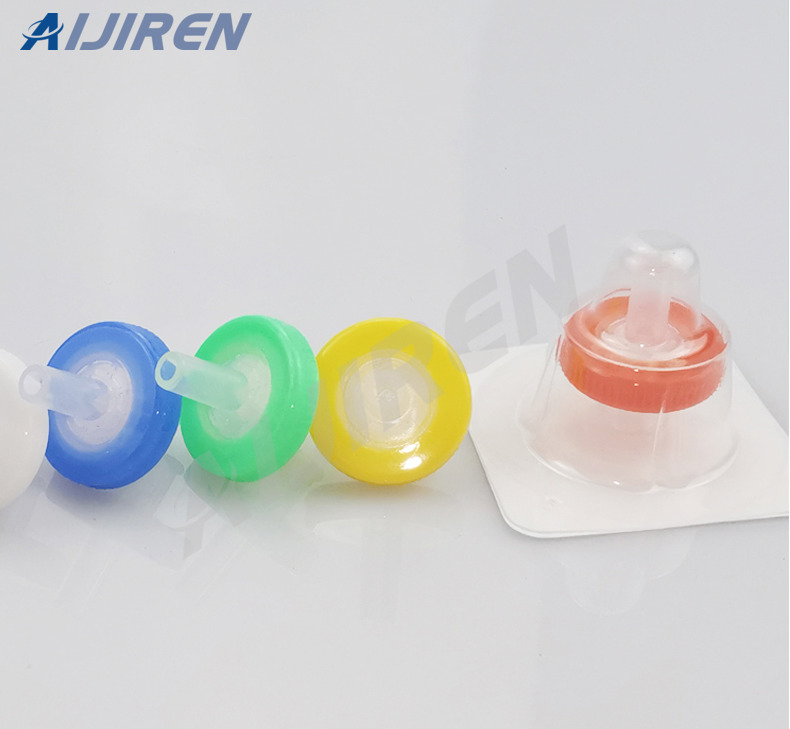
Minisart filters have a Luer Lock inlet and outlet, for positive attachment to the syringe. The filter is 26 mm in diameter with a hold-up volume of 0.1 mL. Suitable for clear aqueous solutions not requiring preliminary filtration.

Dec 02, 2021 · After filtration, solvent was removed under reduced pressure and the crude extracts were obtained. Each extract was solubilized in LC–MS-grade methanol (2 mg·mL −1), filtered using a 0.45 µm syringe filter and analyzed by HPLC–HR-ESI-MS/MS. The analysis was carried out with a sample injection volume of 5 µL and the column temperature

Millex-FA Syringe Filter Unit, 1.0 µm, hydrophobic PTFE, 50 mm, HB-HB, A 50 mm diameter non-sterile syringe filter with a 1 µm filter pore size hydrophobic PTFE membrane. The 1 micron filter comes in a pack of 10.

Syringe filters are used in analytical chemistry applications to remove particulate contamination prior to analysis. Filtering a sample prior to sample injection into analytical instrumentation will help protect sensitive parts of the instrument from particulate build-up and reduce system downtime.

Fill a 10 mL syringe with ultrapure water and equip with a 0.02 μm filter. Discard the initial 1–2 mL syringe filter output. All subsequent steps use 0.02 μm-filtered water. Prepare samples for spotting on mica by diluting to final concentrations of 10–30 μM in water.

• Well characterized materials • Multiple device size and connection options Sterile filter in Grade A Sterile filter in Grade C. Connecting People, Science ...

A 33 mm diameter sterile syringe filter with a 0.22 µm pore size hydrophilic PVDF membrane. Comes in a pack of 50. Simply better membrane technology, simply better Stericup® filters. Millex Sterile syringe filter units are available in a larger 33mm housing with either MCE, PVDF or PES membranes.

View Pricing. 29841-U. eVol ® XR Analytical Electronic Syringe, eVol Kit (includes digital drive, stand, charger with adapters, and three syringes (5, 100 and 1000 μL). View Pricing. 29609-U. Hamilton ® CTC LC syringes, 1750N, volume 500 μL, needle size 22 ga, needle L 51 mm (2 in.) View Pricing. 21321.

Non-sterile Millex® syringe filters you can trust. Chromatography HPLC, IC, GC / General particle removal / Industrial / Environmental Membrane Diameter (mm) Pore Size (µm) Process Volume (hold-up) 50 units/pk 100 units/pk 250 units/pk 1000 units/pk

Push It to the Limit! Multiple Sizes, Materials & Uses, Customized Solutions Minisart ® Syringe Filters: The Industry Leading Syringe Filter - Turning Science into Solutions. Sartorius offers Minisart ® syringe filters for a wide range of applications, including sterile filtration. Our filters are clean and safe as they are almost free of

Sterile filtration, clarification, and particle removal. Minisart ® NML Syringe Filters provide the optimal method for clarification and sterilization of liquids, robustly removing bacteria and particles, without any impact on product quality or loss of target molecule. Superior filter areas up to 6.2 cm 2. 0.1µm to 5µm pore sizes.

Sep 28, 2016 · Filter material. There are many different filter materials used in syringe filters. Some of the most common are cellulose acetate (CA) and polyethersulfone (PES). The key differences are chemical compatibility, flow rate, and burst pressure (i.e. strength).

Polypropylene, nylon, and PTFE membranes are ideal for sample preparation and small volume chemical filtration.Syringe filters are attached to the end of a syringe to remove particles from a sample prior to analysis. Filtering liquids, the single-use devices force liquids through the filter either when fluids are initially drawn or delivered. Circular shaped in diameters that fit common

Millex® Syringe filters set the standard for reliable small volume filtration (1 mL to 200 mL). Available in 4, 13, 25, 33, and 50 mm diameters. Minimal hold-up volume for less sample loss o f small volumes and are ideal for solutions such as antibiotics and tissue culture additives.

raw materials if a correlation has been shown between the levels in the raw materials and components. If there are no safety concerns with the type and level of leachables detected, routine monitoring of leachables would not be necessary.